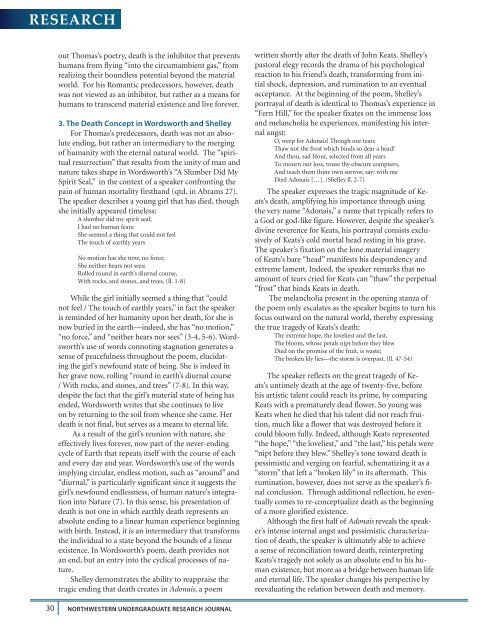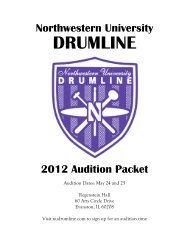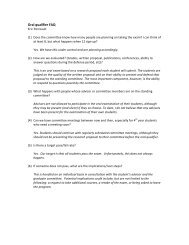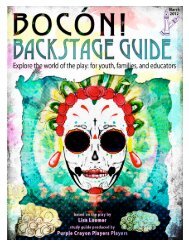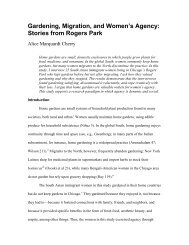research - Associated Student Government, Northwestern University
research - Associated Student Government, Northwestern University
research - Associated Student Government, Northwestern University
You also want an ePaper? Increase the reach of your titles
YUMPU automatically turns print PDFs into web optimized ePapers that Google loves.
RESEARCHout Thomas’s poetry, death is the inhibitor that preventshumans from flying “into the circumambient gas,” fromrealizing their boundless potential beyond the materialworld. For his Romantic predecessors, however, deathwas not viewed as an inhibitor, but rather as a means forhumans to transcend material existence and live forever.3. The Death Concept in Wordsworth and ShelleyFor Thomas’s predecessors, death was not an absoluteending, but rather an intermediary to the mergingof humanity with the eternal natural world. The “spiritualresurrection” that results from the unity of man andnature takes shape in Wordsworth’s “A Slumber Did MySpirit Seal,” in the context of a speaker confronting thepain of human mortality firsthand (qtd. in Abrams 27).The speaker describes a young girl that has died, thoughshe initially appeared timeless:A slumber did my spirit seal;I had no human fears:She seemed a thing that could not feelThe touch of earthly yearsNo motion has she now, no force;She neither hears not sees;Rolled round in earth’s diurnal course,With rocks, and stones, and trees. (ll. 1-8)While the girl initially seemed a thing that “couldnot feel / The touch of earthly years,” in fact the speakeris reminded of her humanity upon her death, for she isnow buried in the earth—indeed, she has “no motion,”“no force,” and “neither hears nor sees” (3-4, 5-6). Wordsworth’suse of words connoting stagnation generates asense of peacefulness throughout the poem, elucidatingthe girl’s newfound state of being. She is indeed inher grave now, rolling “round in earth’s diurnal course/ With rocks, and stones, and trees” (7-8). In this way,despite the fact that the girl’s material state of being hasended, Wordsworth writes that she continues to liveon by returning to the soil from whence she came. Herdeath is not final, but serves as a means to eternal life.As a result of the girl’s reunion with nature, sheeffectively lives forever, now part of the never-endingcycle of Earth that repeats itself with the course of eachand every day and year. Wordsworth’s use of the wordsimplying circular, endless motion, such as “around” and“diurnal,” is particularly significant since it suggests thegirl’s newfound endlessness, of human nature’s integrationinto Nature (7). In this sense, his presentation ofdeath is not one in which earthly death represents anabsolute ending to a linear human experience beginningwith birth. Instead, it is an intermediary that transformsthe individual to a state beyond the bounds of a linearexistence. In Wordsworth’s poem, death provides notan end, but an entry into the cyclical processes of nature.Shelley demonstrates the ability to reappraise thetragic ending that death creates in Adonais, a poemwritten shortly after the death of John Keats. Shelley’spastoral elegy records the drama of his psychologicalreaction to his friend’s death, transforming from initialshock, depression, and rumination to an eventualacceptance. At the beginning of the poem, Shelley’sportrayal of death is identical to Thomas’s experience in“Fern Hill,” for the speaker fixates on the immense lossand melancholia he experiences, manifesting his internalangst:O, weep for Adonais! Though our tearsThaw not the frost which binds so dear a head!And thou, sad Hour, selected from all yearsTo mourn our loss, rouse thy obscure compeers,And teach them thine own sorrow, say: with meDied Adonais […]. (Shelley ll. 2-7)The speaker expresses the tragic magnitude of Keats’sdeath, amplifying his importance through usingthe very name “Adonais,” a name that typically refers toa God or god-like figure. However, despite the speaker’sdivine reverence for Keats, his portrayal consists exclusivelyof Keats’s cold mortal head resting in his grave.The speaker’s fixation on the lone material imageryof Keats’s bare “head” manifests his despondency andextreme lament. Indeed, the speaker remarks that noamount of tears cried for Keats can “thaw” the perpetual“frost” that binds Keats in death.The melancholia present in the opening stanza ofthe poem only escalates as the speaker begins to turn hisfocus outward on the natural world, thereby expressingthe true tragedy of Keats’s death:Thy extreme hope, the loveliest and the last,The bloom, whose petals nipt before they blewDied on the promise of the fruit, is waste;The broken lily lies—the storm is overpast. (ll. 47-54)The speaker reflects on the great tragedy of Keats’suntimely death at the age of twenty-five, beforehis artistic talent could reach its prime, by comparingKeats with a prematurely dead flower. So young wasKeats when he died that his talent did not reach fruition,much like a flower that was destroyed before itcould bloom fully. Indeed, although Keats represented“the hope,” “the loveliest,” and “the last,” his petals were“nipt before they blew.” Shelley’s tone toward death ispessimistic and verging on fearful, schematizing it as a“storm” that left a “broken lily” in its aftermath. Thisrumination, however, does not serve as the speaker’s finalconclusion. Through additional reflection, he eventuallycomes to re-conceptualize death as the beginningof a more glorified existence.Although the first half of Adonais reveals the speaker’sintense internal angst and pessimistic characterizationof death, the speaker is ultimately able to achievea sense of reconciliation toward death, reinterpretingKeats’s tragedy not solely as an absolute end to his humanexistence, but more as a bridge between human lifeand eternal life. The speaker changes his perspective byreevaluating the relation between death and memory.30 NORTHWESTERN UNDERGRADUATE RESEARCH JOURNAL


